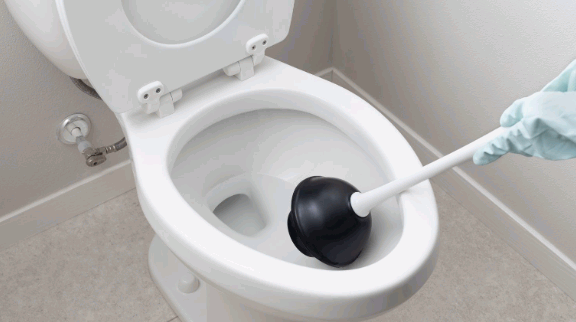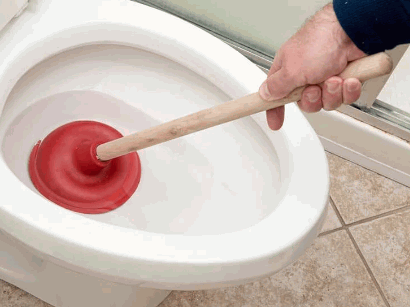
Dealing with a clogged toilet can be a messy and frustrating experience. In such situations, a drain unblocker can come in handy.
But, can you actually use a drain unblocker on a toilet? What are the risks involved?
In this article, we will explore how drain unblockers work, the precautions to take when using them on a toilet, and alternative methods such as plungers and plumbing snakes.
Stay tuned to learn more about effectively unclogging your toilet and when it's time to call a professional plumber.

Table of Contents
A drain unblocker is a method or tool used to clear blocked pipes or drains that are obstructed by rubbish or debris. It can be a chemical product, a natural solution like white vinegar and bicarbonate of soda, or even specialised equipment.
In many cases, chemical cleaners are the preferred option for quickly breaking down blockages caused by grease, hair, and soap scum. These products contain potent substances that dissolve the buildup, allowing water to flow freely again. However, it's important to follow safety instructions and use them sparingly to avoid damaging pipes.
On the other hand, natural remedies such as a mixture of white vinegar and bicarbonate of soda can be kinder to the environment and still effectively deal with minor blockages. These household items can create a fizzy reaction that helps dislodge debris without harsh chemicals.
Explore further: How To Make Your Own Drain Cleaning

A drain unblocker works by clearing obstructions in pipes or drains caused by blockages, which can be due to various factors such as a build-up of waste, grease, or mineral deposits. The method depends on the type of blockage and the chosen cleaner, whether it's hot water, vinegar, and bicarbonate of soda, or a chemical solution.
When dealing with organic blockages like food particles or hair, natural remedies like vinegar and bicarbonate of soda create a fizzing reaction to help break down the debris, making it easier to wash away. On the other hand, chemical drain cleaners contain powerful agents that can dissolve tough blockages quickly, but they should be used with caution due to their corrosive nature.
Using the right technique is crucial in ensuring the effectiveness of the drain-unblocking process. Different types of blockages require targeted approaches; for instance, plunging works best for simple blockages, whereas snaking is more effective for deeper obstructions that need physical removal.

Yes, you can use a drain unblocker on a toilet to clear clogs or blockages in the waste outlet. It's important to wear protective gear like rubber gloves and consider using natural products like white vinegar to avoid damaging the toilet bowl or plumbing system.
Identifying the root cause of the blockage is crucial in effectively resolving the issue. Often, toilet clogs occur due to flushing inappropriate items such as children's toys, sanitary products, or excessive toilet paper. To prevent future blockages, it's advisable to educate household members on what can and cannot be flushed. Regular maintenance, such as using a plunger or drain snake, can also help keep your toilet functioning smoothly.
Using a drain unblocker on a toilet carries certain risks, especially if the wrong products are used. Chemical drain cleaners can damage the porcelain of the toilet bowl or the pipes, while excessive pressure from tools like a pressure washer may cause leaks or further blockages.
The chemical residues left behind by these harsh products can be harmful to the environment, contaminating water sources and affecting aquatic life. Opting for natural solutions such as white vinegar not only helps in keeping the plumbing system safe but also reduces the ecological impact. These eco-friendly alternatives are gentle on the pipes and do not pose the same level of risk as harsh chemical cleaners. Choosing the right method for unclogging a toilet can make a significant difference in maintaining the longevity of your plumbing system.

If you prefer alternatives to drain unblockers for toilets, you can try using a plunger, a plumbing snake, or a mixture of boiling water and dish soap. These methods can help dislodge blockages without the need for chemical products.
Plungers are widely considered a go-to tool for unblocking toilets. By creating a vacuum and pressure, plungers can push and pull obstructions out of the pipes effectively. Alternatively, plumbing snakes, also known as drain augers, are great for reaching deeper blockages that plungers may not be able to access. They work by snaking down the drain to physically break up and remove the blockage.
Another natural solution involves pouring a pot of boiling water down the toilet followed by a mixture of dish soap. The heat from the water can help dissolve organic materials causing the blockage, while the soap acts as a lubricant to help wash away debris.
A plunger is a common tool used to clear toilet blockages by creating pressure to dislodge obstructions. It is essential to use the plunger correctly, ensuring a good seal around the drain to maximise effectiveness.
Before starting, it's crucial to wear rubber gloves to maintain hygiene while handling the plunger.

A plumbing snake, also known as an auger, is a flexible tool used to access and remove blockages deep within toilet pipes. By inserting the snake into the drain and rotating it, you can break up blockages and restore proper flow.
As the auger navigates through the pipes, its coiled design allows it to grasp onto debris and pull it out effectively.
It's crucial to handle any dislodged materials with care to prevent further obstructions.
The flexibility of the snake enables it to bend around curves and navigate through the twists and turns of the plumbing system, reaching blockages that are otherwise challenging to access.
When dealing with stubborn toilet blockages, employing a plumbing snake can be a cost-effective and efficient solution before contacting a professional plumber to address more severe issues.

A mixture of boiling water and washing-up liquid can be an effective and natural way to dissolve toilet blockages caused by organic matter or greasy residues. Pouring the solution into the toilet and allowing it to sit can help break down the blockage over time.
As hot water is a powerful solvent, combining it with washing-up liquid creates a potent solution that can tackle stubborn blockages without harsh chemicals. The heat helps to liquefy the oily substances while the soap aids in breaking them apart.
To use this method, start by heating water until it reaches near boiling point but not boiling to avoid damaging the porcelain.
Next, add a generous amount of washing-up liquid to the hot water. The soap acts as a lubricant to facilitate the breakdown of the blockage. Stir the mixture gently to ensure proper integration of the soap.

You should use a drain unblocker on a toilet when noticing slow drainage, gurgling sounds, or water backing up in the bowl. It's important to address blockages promptly to prevent more serious issues like damage to the plumbing system or the septic tank.
Ignoring blockages can lead to obstructions in the waste outlet, causing potential overflow or even structural damage to the property. If left unattended, a simple blockage can escalate into a costly repair.
Preventive measures like educating household members about what can and cannot be flushed down the toilet, such as avoiding flushing children's toys or sanitary products, can go a long way in maintaining a healthy plumbing system. Remember, early intervention with a drain unblocker is key to ensuring smooth and hassle-free drainage in your toilet.
When using a drain unblocker on a toilet, it is crucial to wear protective gear like rubber gloves to avoid skin contact with chemicals. Using white vinegar or natural solutions can be safer for the environment and prevent damage to the toilet bowl or plumbing equipment.
Keeping the toilet lid closed during the process is essential to prevent accidental spills or splashes, which can lead to hazardous situations. In case of accidental exposure, immediately wash the affected area with plenty of water and seek medical assistance if needed. After successfully unblocking the drain, ensure proper disposal of any remaining residue or packaging material to prevent potential clogging issues in the future.
Wearing protective gear like rubber gloves is essential when using drain unblockers on toilets to prevent skin exposure to chemicals and contaminants. It helps in ensuring personal safety during the unclogging process.
Rubber gloves act as a barrier between the skin and the potentially hazardous substances present in drain unblockers, safeguarding against irritation and burns. These gloves are designed to resist punctures and provide a sturdy grip, enhancing control and manoeuvrability while handling the unclogging procedures.
Choosing the appropriate gloves not only protects the hands from harm but also maintains proper hygiene standards in the unclogging process, reducing the risk of contamination and ensuring a safe and efficient experience.

Proper ventilation is crucial when using drain unblockers on toilets, especially if chemical products are involved. Opening windows or using fans can help dissipate fumes and maintain air quality during the unclogging process.
When unclogging toilets with drain unblockers, it's essential to consider the potential health risks associated with inhaling chemical fumes. Poor ventilation can lead to the accumulation of harmful substances in the air, posing dangers to both your respiratory system and overall well-being. To combat this, you can install an exhaust fan in the bathroom or utilise a dehumidifier to enhance air circulation and reduce the concentration of pollutants.
To ensure the safe and effective use of drain unblockers on toilets, it is vital to follow the manufacturer's instructions carefully. Proper application and adherence to guidelines can prevent mishaps and optimise the unclogging process.
By carefully reading and implementing the provided instructions, users can avoid chemical spillage and accidental damage to the toilet system. Proper application techniques not only ensure safety but also enhance the efficacy of the unblocker, enabling it to dissolve blockages efficiently. Attention to detail in product usage is crucial in avoiding harmful interactions and promoting environmental sustainability.
Proper disposal of drain unblockers is crucial to prevent environmental contamination and plumbing issues. Avoid flushing excess chemicals down the toilet and consider using the local hazardous waste disposal facility to discard any leftover products safely.
Improper disposal of drain unblockers can lead to significant environmental and health risks. Flushing these chemicals down the drain can not only damage your septic tank but also find their way into water sources, causing contamination. To ensure responsible waste management, always follow the guidelines provided on the product label for disposal. Recycle where possible or get in touch with your local waste management facility for guidance on disposing of these substances safely. By taking these simple steps, you can protect both your plumbing system and the environment from harm.
Certain signs indicate the need for a professional plumber when dealing with toilet blockages, such as persistent blockages, foul odours, or unusual noises in the plumbing system. If DIY methods fail or if there are concerns about the septic tank or main waste line, it is advisable to seek expert assistance.
One of the key red flags that suggest the involvement of a professional plumber is when toilet blockages occur frequently, indicating a deeper issue that needs specialised attention.
Sewer smells emanating from drains or toilets can point to a potential problem in the sewer line, which should be promptly addressed to prevent further damage.
For complex issues related to septic tanks or underground plumbing, professionals possess the knowledge and equipment necessary to diagnose and repair the problem effectively, ensuring the longevity and efficiency of the overall plumbing system.